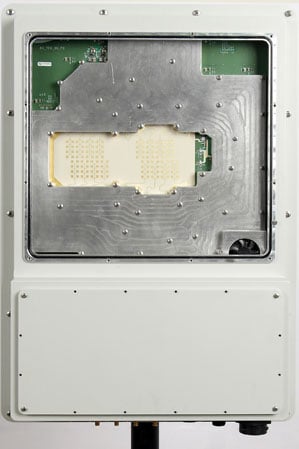Samsung Says New Superfast “5G” Works with Handsets in Motion
When Samsung announced two weeks ago that it had prototyped a new wireless technology that could transmit data far faster, many researchers were skeptical because the high-frequency signal is easily blocked and would be hard to work in moving handsets (see “Crazy-Fast Wireless Tested in New York”).

But the 5G project’s leader in Korea now says tests at Samsung labs there showed the technology worked well when the device receiving data was moving at the speed of a runner, eight kilometers per hour. The testing also found that the novel wireless link could reach 200 meters even when there was no direct line-of-sight.
Those results suggest that the technology could be practical for mobile devices in an urban environment, allowing people walking to receive data at least several times faster than is possible today, said Wonil Roh, head of the Advanced Communications Laboratory at Samsung’s R&D center in Suwon, South Korea. “The bottom line is that we had some very encouraging tests which demonstrate how fast our beam-forming and tracking technology is working,” he says.
Roh said that in tests—with a transmitter mounted on an outside wall at the third-floor level of an 11-story concrete building and the receiver moving around, with part of the building blocking the signal—the new technology delivered error-free data at 256 megabits per second, reaching a rate of 512 megabits per second with negligible errors. This compares to the theoretical maximum of about 75 megabits per second that current 4G LTE technology can provide.
Samsung had not previously offered this much detail on its new technology’s capabilities. The company’s initial announcement talked only of ultrafast speeds with an unimpeded line-of-sight connection—one gigabit at up to two kilometers.
However, neither the results described in Samsung’s initial announcement or in Roh’s subsequent interview with MIT Technology Review have been published. Victor Bahl, principal researcher and manager of the mobility and networking research group at Microsoft Research, says it would be difficult to assess the technology before this happens. And ultimately, Samsung will have to “show how [it] scales to accommodate real users in real settings,” he says.
But if Samsung’s claims pan out, it would be a big deal, says Vanu Bose, CEO of a wireless infrastructure company in Cambridge, Massachusetts, and a technical advisor to a recent White House report on making more radio spectrum available for wireless networks. “If they have solved this, then they have opened up a large number of higher frequencies for cellular-type use, which are really not useful for cellular today,” he says. The Samsung technology relies on 28-gigahertz frequencies—also known as “millimeter wave”—which are roughly an order of magnitude higher than the cellular frequencies used today and, as such, can carry commensurately more data.
However, Bose was quick to add that the characterizations of how Samsung’s technology performs released to date—especially about how well they get around what kids of building obstructions—are “too vague to really say anything concrete,” he added. Roh says a publication is in the works and might be released in June or July.
Samsung and other major players in wireless technology are currently jockeying for position to influence the next wave of standards beyond the existing one, known as 4G LTE, says Dipankar Raychaudhuri, director of the wireless research lab at Rutgers University. Although Samsung calls its work part of a “core technology” for a possible future 5G standard, only the International Telecommunications Union, an agency of the United Nations, can formally declare a new 5G standard.
Transmitting at ultrafast speeds is a headline-grabbing event. “It’s like a beauty contest—everybody wants to make the fastest radio,” says Raychaudhuri, “but the future is not about only speed.” Cellular customers will also demand more complete coverage, fewer dropped calls, and lower latency in delivering data, he says, and this will require upgrades to cellular networks and how they operate that go beyond just higher speeds.
Whether the Samsung technology proves commercially viable or not, it is technically rather remarkable. The high frequencies it uses can be blocked by buildings, rain, and other obstructions, a problem Samsung gets around by using 64 antennas in both the transmitter and receiver, and rapidly switching which transmitter and receiver beams carry data depending on which can get the clearest signal. The current design can switch which antennas are sending and receiving data in milliseconds as a handset moves, signals bounce off walls or people, or obstructions get in the way. This approach, known as “beam-forming,” is described in a Samsung patent filing. However, the company will also need to find a way to cram 64 antennas into a mobile device if its new technology is to succeed.
Keep Reading
Most Popular
Large language models can do jaw-dropping things. But nobody knows exactly why.
And that's a problem. Figuring it out is one of the biggest scientific puzzles of our time and a crucial step towards controlling more powerful future models.
The problem with plug-in hybrids? Their drivers.
Plug-in hybrids are often sold as a transition to EVs, but new data from Europe shows we’re still underestimating the emissions they produce.
How scientists traced a mysterious covid case back to six toilets
When wastewater surveillance turns into a hunt for a single infected individual, the ethics get tricky.
Google DeepMind’s new generative model makes Super Mario–like games from scratch
Genie learns how to control games by watching hours and hours of video. It could help train next-gen robots too.
Stay connected
Get the latest updates from
MIT Technology Review
Discover special offers, top stories, upcoming events, and more.